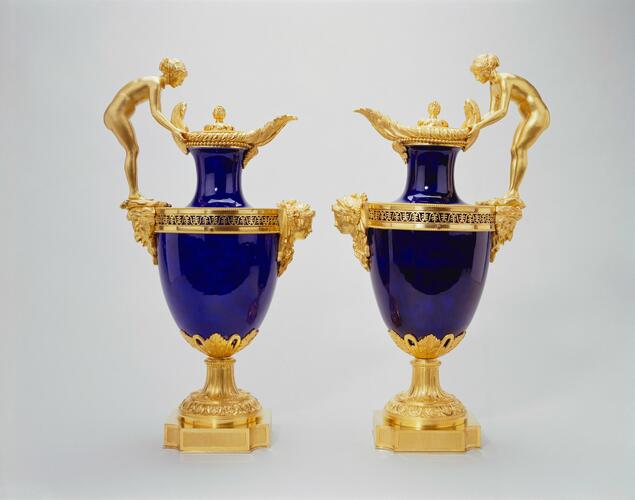Vase à monter c. 1782-6
Hard paste porcelain, gilt bronze | .1 41.5 x 23.0 x 13.5, .2 41.0 x 24.2 x 13.7 cm (whole object) | RCIN 35513
-
Sèvres hard paste porcelain pair of vases mounted as ewers. Dark blue ground with gilt bronze mounts, vase egg shape with chased mounts, the handle formed as a naked girl standing on a cushion bending forward to a scallop shell, the neck pierced with a band of anthemions and female masks to either side, circular stem foot on shaped base.
Provenance
Probably acquired by George IV through his intermediary, Dominique Daguerre, in the late 1780s. As the entries in the Carlton House accounts and ledgers do not distinguish between the two similar pairs in the Royal Collection they are here considered together. In 1803 one pair passed through the hands of Benjamin Vulliamy, who regilded all the mounts except for those on the beaker section of one of the vases. Three years later Vulliamy undertook the repair, partial regilding and cleaning of both pairs at a cost of £45 16s. They were entered in Benjamin Jutsham’s Carlton House receipts’ ledger on 11 June 1807, when they were returned to the Admirals Room on the Principal Floor before being placed in store. By 1826 both pairs stood in the Crimson Drawing Room, Principal Floor. They are described in the inventory as ‘4 Beautiful small Seve Porcelain Vases of blue ground, mounted on ormolu stands, ormolu bands round the tops enriched with Satyr and female heads, the handles being formed of Female Figures also in ormolu, a stand and glass shade to each; In [sic] high’. In 1903 both pairs of ewers were restored by Henry J. Hatfield, at a cost of £2 13s 6d and £4 4s. respectively. In the case of one pair Hatfields supplied a ‘pearl bead ring under both lips’ and a replacement knob for one of the ewers; they also regilded the other mounts and added plates for fixing the ewers to the chimney-piece.
Pierre-Philippe Thomire was the outstanding Parisian bronzeur and gilder of the early nineteenth century. He supplied finely chased mounts to leading Parisien ébénistes for furniture, clocks and the Sèvres porcelain factory. He was much patronised by Napoleon who made him Ciseleur de l'Empereur. His work represents some of the finest examples of Empire style.
In 1804 he acquired business of the marchand-mercier, Martin-Eloi Lignereux. The company employed a large workforce in a workshop at rue Boucherat and a showroom at rue Taitbout, from where Thomire retailed a large range of decorative objects inspired by antiquity including candelabra, extravagant centrepieces, clock cases and monumental Greek and Roman style urns and vases.
Thomire collaborated with three partners, renaming the business for a time Thomire, Duterme et Cie. The business suffered as a result of France's continuing European hostilities and to avoid bankruptcy the firm was granted dispensation to trade with the Prince Regent . Soon after 1815 the partnership with Duterme was dissolved and, under the old style, Thomire et Cie thrived once more under the restored Bourbons.
Thomire retired in 1823 and his two sons-in-law, Louis-Auguste-Cesar Carbonelle and André-Antoine Beauvisage, continued the business until 1852. Thomire continued to work as a sculptor and exhibited regularly at the Salon until 1834.
-
Creator(s)
(porcelain manufacturer)(nationality)(metalworker)Acquirer(s)
-
Medium and techniques
Hard paste porcelain, gilt bronze
Measurements
.1 41.5 x 23.0 x 13.5, .2 41.0 x 24.2 x 13.7 cm (whole object)
Other number(s)
Laking PC : Laking, G.F., 1907. Sèvres Porcelain of Buckingham Palace and Windsor Castle, London – Laking PC 247Alternative title(s)
Pair of vases mounted as ewers
Place of Production
Sèvres [France]









